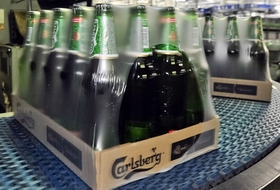 Carlsberg AS, the world’s fourth biggest brewer, is focusing on making its packaging more sustainable this year and beyond, according to Morten Nielsen, its director of corporate social responsibility.
Carlsberg AS, the world’s fourth biggest brewer, is focusing on making its packaging more sustainable this year and beyond, according to Morten Nielsen, its director of corporate social responsibility.The company identified that about 45 percent of its CO2 emissions is attributed to packaging, with primary packaging – bottles and cans – having the biggest impact. “We’ve put together a strategy to address this issue and reduce the negative impact,” said Nielsen. As a first step, the brewery has introduced a life-cycle analysis tool to further assess the impact of its packaging.
The brewery has a “clear ambition to market [environmental sustainability] as part of its consumer agenda,” said Nielsen. “As we are a branded company, we simply have to engage with consumers and stakeholders.”
Consumers, he said, are happy to participate. The challenge lies in “whether they should pay a premium, or if they would rather be rewarded,” he said.
Q: Water and energy are two priorities for the brewery business. Tell us about what you’re doing in those areas.
A: We have placed a lot of efforts on making efficient use of natural resources and our measures around water and energy consumption. As part of energy, we also measure our CO2. This focus has paid off, in the sense that we’re doing pretty well compared to other brewing companies in terms of water, energy and CO2. Reducing our consumption has been a focus for us for many years, and we have been very successful in sharing best practices across the group.
Q: With the price of wheat and barley rising, how has that affected operations?
A: We are working on sustainable agriculture through some targeted projects. For example in Poland, Russia and China, we’re improving the yields and quality of crops. We supply contracts to farmers and provide them with certified seeds of modern varieties. In return, the farmers will sell a share of the harvest to us. That puts our company first in line for purchase of surplus yield.
Q: Taking climate change into consideration, is the company also exploring barley substitutes in the event of drought.
A: Carlsberg is an all-malt brand and so we put a lot of our focus into developing efficient and sustainable barley types. We’re also developing special barley varieties which provides taste, extends the shelf life of beer and enhances the beer brew. This translates to less refrigeration during storage and transportation of the beer. In recent years, we’re starting to pay more attention to selecting and breeding heat-and-drought tolerant barley varieties which generate high yields of quality but with less water requirements in the growth seasons. We expect this will result in more climate-tolerant plants with less demand for water.
Q: Speaking of water, what are your?efforts on that outside of agriculture?
A: We’re looking into ways of recycling water in the brewery itself. For example, you can use some of the excess water running though the water treatment plant and reuse it for cleaning purposes inside the brewery, and lead it back to the treatment plant. This way, it’s used again and again. This has proved to be a relatively simple but effective way of reducing consumption. We are also constantly upgrading and maintaining our equipment to ensure that our water consumption is kept as low as possible.
Q: Forty-five percent of CO2 emissions is from packaging. Based on your analysis, which area has the most impact?
A: The biggest impact is in the primary packaging – the bottle or the can. Looking at the end-to-end CO2 emissions, we are currently at 7.3 kilograms per hectolitre. Out of this, 3.0 kg/hl comes from primary packaging. Secondary packaging would be the crates of the box. It’s quite energy consuming to produce glass bottles. You have to heat the raw materials up to a very high temperature. It’s the explanation for why it’s so dramatic for primary packaging. We’ve put together a strategy to address this issue and reduce the negative impact and that embraces reducing the amount of packaging material.
For instance, our light-weighing bottles. We work to increase the reuse of glass bottles. And on a third dimension, recycling them and that’s when we encourage consumers to recycle packaging and increase the amount of recycled content in new packaging. We recycle it, crush it and recycle the material into new packaging.
Lastly, we engage in a rethink program where you innovate new ways of packaging and start considering used packaging as waste, and using it as a resource for other products. In 2012, we’ve established a baseline for how much packaging weighs. We’re looking at CO2 emissions from packaging and are now trying to quantify the potential for reducing packaging, weight and CO2 emissions. It’s early days to reveal numbers but by reducing our packaging weight, we are expecting to reduce costs for packaging materials.







